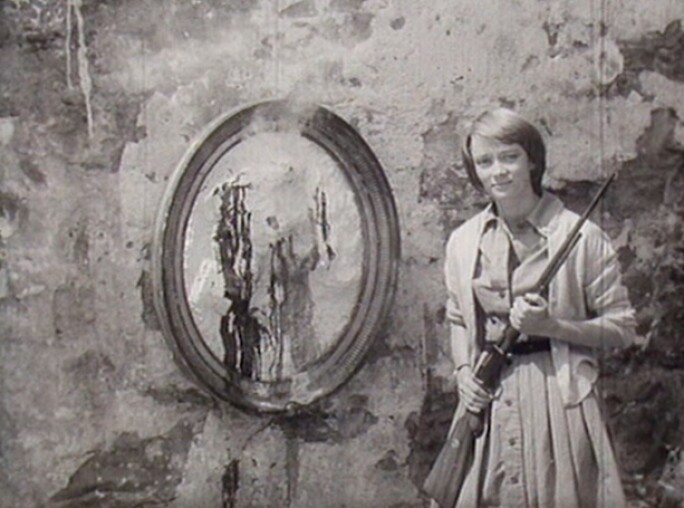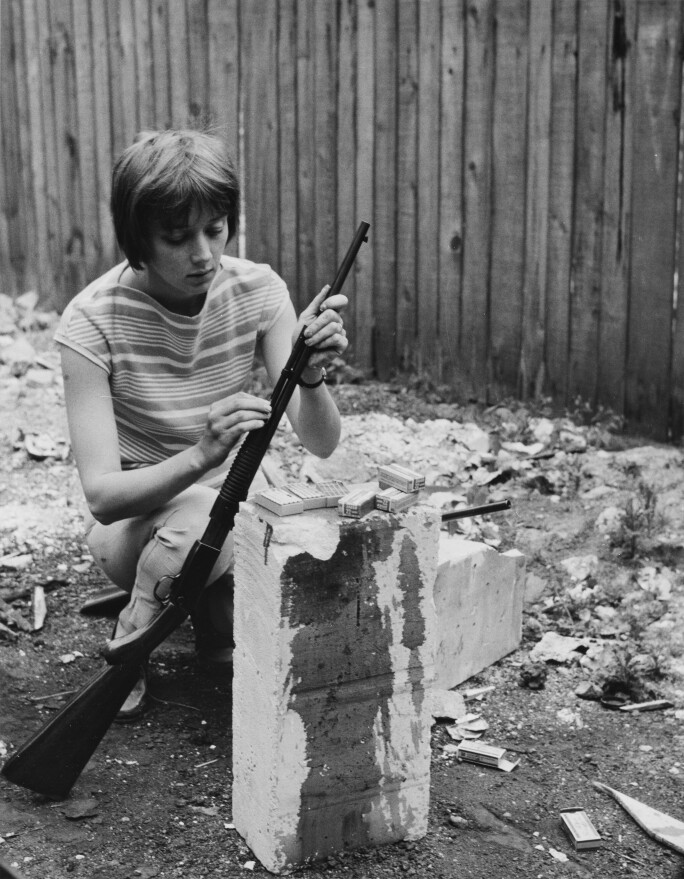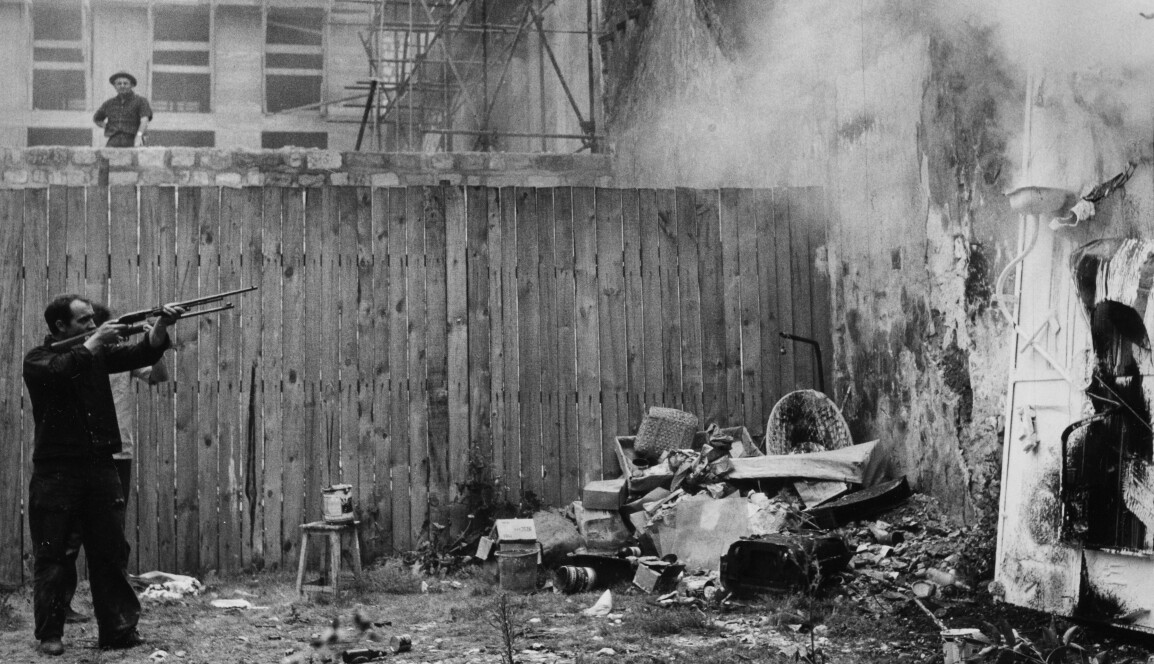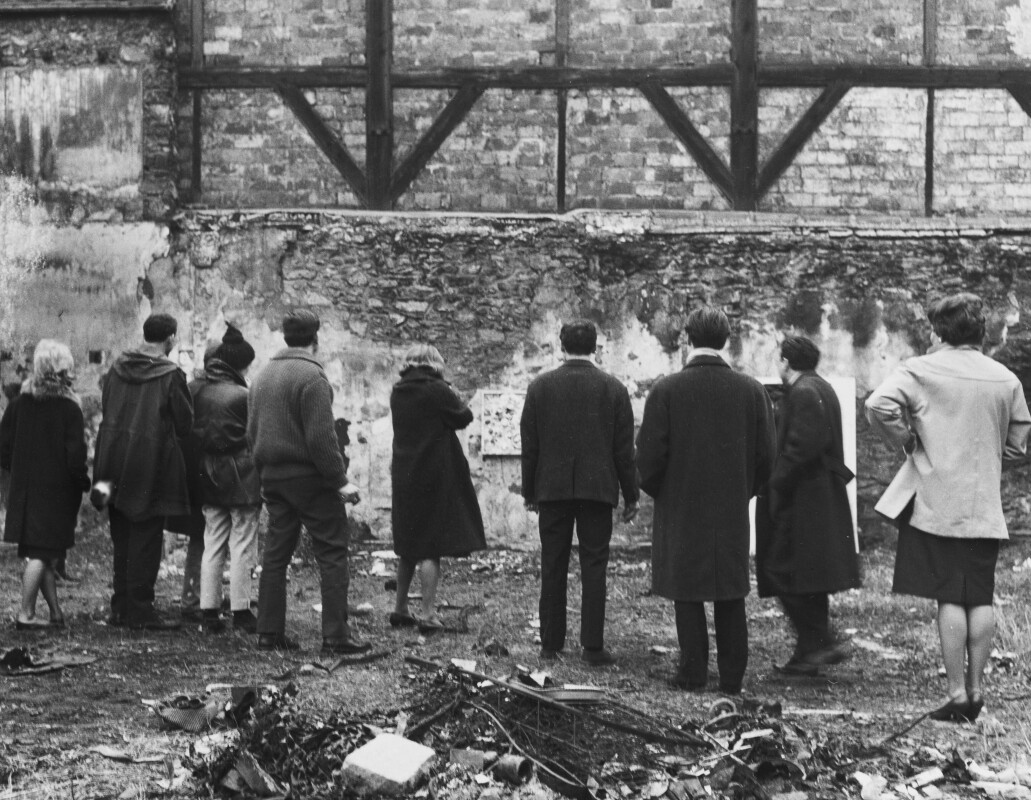
“By shooting at myself, I was shooting at society and its injustices. By shooting at my own violence, I was shooting at the violence of the era.”
Executed in 1961, this work constitutes a seminal and historically significant example from Niki de Saint Phalle's renowned Tirs series. Unveiled during the artist’s inaugural solo exhibition, entitled Feu à volonté and hosted by Galerie J, this Tir emerges as a pioneering endeavor in her quest to subvert conventional pictorial methodologies. By personally engaging in the act of shooting and inviting spectators to fire a .22 Long Rifle at assemblages of white plaster and assorted objects concealing pockets of colour and paint-filled capsules, Saint Phalle presents a transgressive and participatory performance. Aspiring to "break down the barrier between the spectator and the object," she empowers the audience to actively contribute to the final composition of the piece. It was through this groundbreaking gesture that she persuaded the art critic Pierre Restany to include her in the Nouveaux Réalistes movement, alongside artists such as Jean Tinguely, Martial Raysse and Jacques Villeglé.
The acquisition of this piece by Marcel Lehman-Lefranc, a collector and confidant of Niki de Saint Phalle, imbues it with exceptional significance. Present at one of the artist’s emblematic shooting sessions, Lefranc was the sole purchaser of a work from this inaugural exhibition, along with Robert Rauschenberg, who would go on to receive the Golden Lion at the Venice Biennale three years later. Although esteemed institutions such as MoMA and the Centre Pompidou subsequently acquired analogous works, this particular Tir is distinguished by its profound connection to a pivotal moment in Saint Phalle’s creative evolution, offering a rare testament to the privileged dialogue between the collector and the artist’s visionary process.
“I can only combat pain and sorrow through action. Action is my weapon.”

Each shot penetrates the plaster surface, allowing the paint to “cry” onto the composition in a display of poignant violence, heightened by the vivid hues that strikingly contrast against the stark white background. The artwork, both fragmented and arresting, encapsulates the artist’s raw expressiveness in its entirety. Preserved in its final state—immortalized at the very moment of bullet impact without any subsequent alteration—it stands as a compelling testament to unadulterated authenticity. This cathartic performance represents Saint Phalle’s visceral response to the injustices of patriarchal society, the conflicts of her time, and the traumas endured within her own family. The artist’s rifle becomes a potent symbol of critique, with each shot serving as an act of deliverance and liberation.
Scarred by a childhood that was at once privileged and troubled, Niki de Saint Phalle sought refuge in art during the early 1950s. In a letter addressed to her husband, Jean Tinguely, in October 1989, she wrote:"I can only combat pain and sorrow through action. Action is my weapon." Her early target-paintings were first presented at the exhibition Comparaisons: peintures-sculptures at the Musée National d’Art Moderne in Paris in February 1961, where she exhibited Portrait of my love: Hors d’œuvre and Saint Sébastien (1960-1961). It was during this period that she conceived the notion of affixing a white shirt onto a canvas, surmounted by a target in place of a head, inviting the public to hurl darts at it. The resounding success of this initiative emboldened her to further intensify the experience through rifle shooting, reaching an apex of violence that she herself described as"a murder without a victim."
This Tir epitomizes the very essence of Niki de Saint Phalle’s avant-garde approach. Through its raw immediacy and profound emotional resonance, this masterwork transcends the realm of mere artistic objects to embody an act, an experience. As an iconic milestone in her artistic journey, the offering of this exceptional piece represents a unique opportunity to acquire a tangible fragment of revolutionary and profoundly human vision.
Tir Old Master – Niki de Saint Phalle
-
 Sotheby's StoriesHow Jane Birkin's Original Hermès Birkin Bag Made History... Again | A Sotheby's Auction Story
Sotheby's StoriesHow Jane Birkin's Original Hermès Birkin Bag Made History... Again | A Sotheby's Auction Story -
 Handbags & FashionJane Birkin's Original Hermès Birkin Bag Shatters Auction Records at $10.1 Million | Sotheby's
Handbags & FashionJane Birkin's Original Hermès Birkin Bag Shatters Auction Records at $10.1 Million | Sotheby's -
 Geek WeekA 54-Pound Martian Meteorite Just Landed at Sotheby's — But How Did It Get Here?
Geek WeekA 54-Pound Martian Meteorite Just Landed at Sotheby's — But How Did It Get Here?
« En tirant sur moi, je tirais sur la société et ses injustices. En tirant sur ma propre violence, je tirais sur la violence du temps. »
Exécutée en 1961, cette œuvre est un exemple éminemment historique de la série des Tirs de Niki de Saint Phalle. Présentée lors de la toute première exposition personnelle de l’artiste, intitulée ‘Feu à volonté’ et organisée par la Galerie J, ce Tir s’impose comme une œuvre pionnière dans la démarche de l’artiste de subvertir les approches picturales traditionnelles. En tirant elle-même et en invitant les spectateurs à tirer à l’aide d’un fusil 22. Long Rifle sur des compositions de plâtre blanc et d’objets divers recouvrant des poches de couleurs et des bombes de peinture, Niki de Saint Phalle propose une performance transgressive et collaborative. Elle qui souhaite « briser le mur entre le spectateur et l’objet » en laissant le public contribuer à la formation finale de son œuvre convainc à cette occasion le critique d’art Pierre Restany de l’intégrer au groupe des Nouveaux Réalistes aux côtés de Jean Tinguely, Martial Raysse ou encore Jacques Villeglé.
L’acquisition de cette œuvre par Marcel Lehmann-Lefranc, collectionneur et proche de Niki de Saint Phalle, revêt une dimension exceptionnelle. Présent lors d’une des emblématiques séances de tir de l’artiste, Lefranc fut le seul acheteur d’une des œuvres de Niki à l’issue de cette première exposition, avec celui qui gagnera trois ans plus tard le lion d’or de la Biennale de Venise : Robert Rauschenberg. Bien que des institutions prestigieuses telles que le MoMA et le Centre Pompidou aient acquis ultérieurement des œuvres similaires, ce Tir se distingue par son ancrage dans un moment clé de la pratique de Saint Phalle, offrant un rare témoignage d’un dialogue privilégié entre Marcel Lehmann-Lefranc et la démarche créative de l’artiste.

« Je ne peux combattre la douleur et la tristesse que par l'action. L'action est mon arme. »
Chaque tir perce la surface de plâtre, laissant la peinture « pleurer » sur la composition dans une violence bouleversante, accentuée par des couleurs vives qui se détachent vivement du fond blanc du plâtre. L’œuvre, à la fois éclatée et saisissante, est restituée par l’artiste dans toute son expressivité. Elle demeure dans son état final, figée dans l’instant même de l’impact des balles, sans la moindre retouche, témoignant ainsi d’une authenticité brute. Cette performance cathartique est pour Niki une réponse à l’injustice de la société patriarcale, à la violence des guerres de son époque mais également à celle qu’elle a vécue dans sa propre famille. Le fusil de l’artiste est une arme critique où chaque balle conjure et libère l’artiste.
Marquée par une enfance à la fois privilégiée et tourmentée, Niki de Saint Phalle se réfugie dans l’art au début des années 1950. Dans une lettre écrite à son mari Jean Tinguely en octobre 1989, elle dit « Je ne peux combattre la douleur et la tristesse que par l'action. L'action est mon arme. ». On retrouve ces premiers « tableaux-cibles » lors de l’exposition Comparaisons : peintures-sculptures au Musée National d’Art Moderne de Paris en février 1961, où elle présenta Portrait of my love: Hors d'œuvre et Saint Sébastien (1960-1961). Niki de Saint Phalle eut l’idée d’apposer sur la toile une chemise blanche, surmontée d’une cible à la place de la tête, invitant le public à y lancer des fléchettes. Le succès de cette initiative la poussa à intensifier l’expérience avec le tir au fusil, atteignant un sommet de violence qu’elle qualifia elle-même de « meurtre sans victime ».
Ce Tir incarne l’essence même de la démarche novatrice de Niki de Saint Phalle. À travers son immédiateté brute et sa charge émotionnelle, ce chef-d'œuvre dépasse le simple objet d’art pour devenir un acte, une expérience. Véritable manifestation du tournant de sa carrière artistique, la vente de ce lot exceptionnel est une occasion unique d’acquérir un témoignage d’une performance iconique, tout en capturant un fragment d’une vision à la fois révolutionnaire et profondément humaine.



